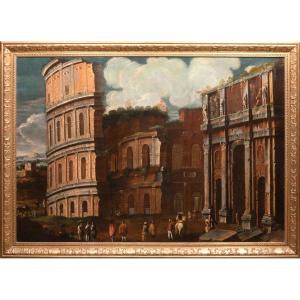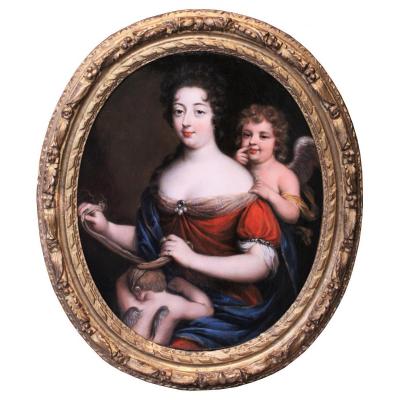The young woman is painted three quarters and portraiture sitting and surrounded by love. The princess, with a thoughtful and sensual look, wears her curly hair, whose long locks escape at the back and fall on her shoulders, she is dressed in a set composed of light and airy fabrics, adorned with a sapphire mounted and embellished with three pearls, leaving his throat and shoulders uncovered. She wears a ring adorned with sapphire to the little finger and a pearl to the ear hidden in her hair. The winged putto hidden behind his shoulder, smiles, displaying a light and mischievous air. In her hands the princess holds a veil that she uses to wrap the eyes of the Love who leans on her knees hides her head in her lap. A light that delicately lightens the face and the white pulpit of our princess envelops the whole group and creates an atmosphere full of sweetness and sensuality.
The work that undoubtedly inspired our painter is the famous painting of Titian: "Venus bandaging the eyes of Love" or "The education of Love", circa 1565, Galleria Borghese, Rome. Venus is represented bandaging the eyes of Love, her son, to punish him for having shot his arrows at random. In our painting as in Titian's, the putto who sees, leaning against the shoulder of Venus, would incarnate the heavenly Love raising the human soul, while the blindfolded one would return to earthly Love. Thus Love with open eyes is an allegory of chaste love or conjugal love while the blindfolded represents blind passion.
Oval canvas with its original gilt wood frame and finely carved. Dimensions: h. 81 cm, l. 68 cm
Period 17th century, workshop of Pierre Mignard
Pierre Mignard French painter (Troyes 1612-Paris 1695). Student of Vouet, he worked in Italy, especially in Rome, from 1635 to 1657, before joining Paris at the request of Louis XIV; he then executed several orders, such as the dome of Val-de-Grace (1663). A renowned portraitist, he knew how to flatter the model, but also to mix expression with grace in light and fresh tones, in contrast to the majesty of Le Brun. On the death of his rival (1690), he succeeded him as the first painter of the king and director of the Manufacture des Gobelins.























 Le Magazine de PROANTIC
Le Magazine de PROANTIC TRÉSORS Magazine
TRÉSORS Magazine Rivista Artiquariato
Rivista Artiquariato
